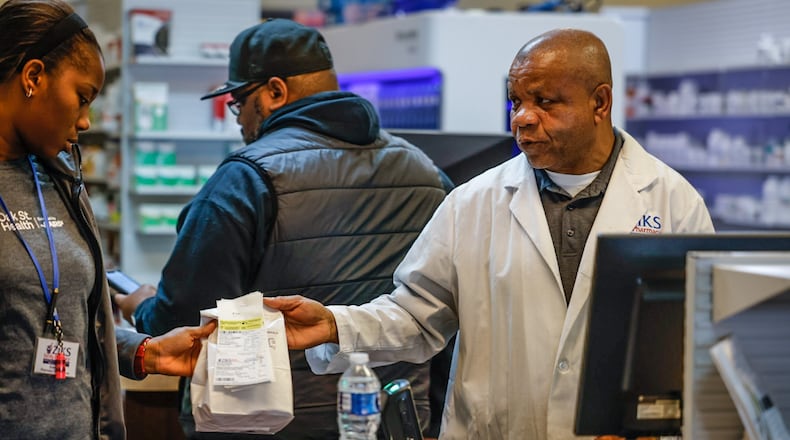The spending cap comes from the Inflation Reduction Act of 2022, which included a redesign of Medicare’s Part D benefit that puts a limit on annual out-of-pocket spending on prescription drugs. Medicare Part D provides prescription drug coverage for nearly 56 million Medicare beneficiaries, according to AARP.
Starting in January 2025, enrollee out-of-pocket costs will be limited to $2,000 per year; this amount will be updated annually with the other parts of the Part D benefit, AARP says.
New savings on drug costs
Under the Medicare Part D benefit many enrollees were originally required to pay 5% of their prescription drug costs, with no limit, even after their out-of-pocket spending reached a certain threshold and they entered “catastrophic coverage,” AARP said.
Catastrophic coverage is another protection under Medicare Part D to protect enrollees from very high out-of-pocket costs for prescription drugs. In 2024, that limit was $8,000, according to Medicare.
AARP’s recent analysis finds Medicare drug plan enrollees nationwide who reach the new out-of-pocket cap will see average savings of roughly $1,500, or 56%, in 2025 for their prescription drugs.
An average of 420,000 enrollees, or 12%, will experience savings of $3,000 or more between 2025 and 2029, AARP says.
People struggling to keep up with drug costs are often people already facing challenging health conditions. One AARP Ohio member, Carol Sarbaugh, of Zanesville, is managing multiple autoimmune conditions, which will worsen as she gets older.
Sarbaugh is a recent retiree on Medicare for the first time. Her out of pocket expenses at the end of June 2024 exceeded $1,800. She is on track to have out of pocket expenses by the end of 2024 that will be around $4,000.
“I’ve had to choose not to take some medications,” Sarbaugh said. “...We just have to put aside some of what our plans were as far as retirement.”
Make sure your drugs are covered
The devil is in the details, one local expert said, who is cautioning people on Medicare to make sure they pay attention to whether or not their prescriptions are part of the preferred formularies for different Part D and Medicare Advantage plans.
“When you join a particular plan, you need to make a comparison as to what drugs are covered by that plan because some plans have what is known as a formulary and they will only cover certain drugs,” said Doug McGarry, executive director of the Area Agency on Aging serving the Dayton region.
“If you are in a plan and you are taking a particular prescription drug, you need to make sure that the drug that you are taking is actually part of their formulary plan,” McGarry said.
For certain drugs, a plan may not cover one the cost of a drug that an enrollee is taking, but it may cover one that similar, he said.
“Which may or may not work for you or what your doctor thinks that you need,” McGarry said. “So that’s where it gets to be complicated.”
Even if the enrollee’s plan covers the drug in 2024, those forumlaries could change in 2025 or future years, he said.
‘If you’re buying in bulk, there ought to be some savings’
It’s unclear who will be absorbing the costs of these drugs after the out-of-pocket spending limit is hit, but it will likely be a mix of the plan provider and the drug manufacturer. Monthly premiums could be impacted, but the Medicare plans for 2025 are not available yet. Those will become available in October.
Medicare Part D is coverage offered by private insurance companies, which have contracts with the federal government. Similarly, Medicare Advantage (also known as “Part C”) is a type of Medicare health plan offered by a private company that contracts with Medicare. These plans include Part A, Part B, and usually Part D, Medicare says.
AARP will be watching how CMS and managed care plan providers under Medicare Advantage will include the spending cap in their plans, Carlson said.
“That is something we’re going to continue to watch because insurance companies are mindful of the fact that these drugs are put into place,” Carlson said. “We’re going to continue to watch what happens from an insurance plan coverage for all of our older Americans, Ohioans, moving forward.”
Drug companies could see reduced profits, which are generally in the tens of billions each year for major drug companies.
Johnson and Johnson has 25 products generating more than $1 billion each annually, the drug company said in its investor fact sheet. For the second quarter of 2024, Johnson and John reported $22.5 billion in sales with net earnings of $4.7 billion, according to its earnings report.
Medicare has not been able to negotiate drug costs before, Carlson said, but that changes with new rules from the Inflation Reduction Act.
“In the United States, on average, we were paying two to three times more for the same prescriptions as other countries because so many people receive Medicare benefits or VA benefits or other benefits, and they were unable to negotiate,” Carlson said.
“If you’re buying in bulk, there ought to be some savings,” Carlson said.
The Ohio Department of Insurance provides Medicare beneficiaries with free, objective, health insurance information and one-on-one counseling through the Ohio Senior Health Insurance Information Program (OSHIIP). For more information, call the OSHIPP hotline at 800-686-1578, email OSHIIPmail@insurance.ohio.gov or visit insurance.ohio.gov/about-us/divisions/oshiip.
By the numbers
Other findings from AARP’s recent report include:
- Between 3 and 4 million Part D plan enrollees nationwide are estimated to benefit from the new out-of-pocket cap every year between 2025 and 2029, including up to 163,000 in Ohio.
- By 2029, the share of enrollees benefiting from the new out-of-pocket cap is estimated to be 10% or higher in 19 states, plus the District of Columbia.
- More than three-quarters of Medicare drug plan enrollees who will benefit in 2025 are between the ages of 65 and 84.
About the Author

